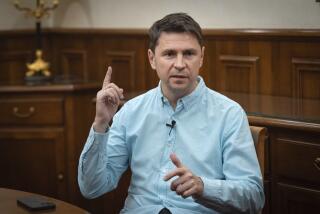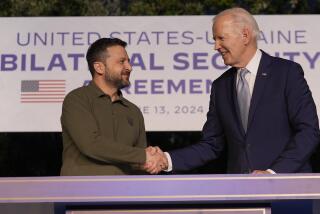U.S., Russia agree to slash nuclear arsenals
Reporting from Washington — American and Russian officials have reached a deal to slash their nuclear arsenals after eight months of unexpectedly tough negotiations, sources close to the talks said Wednesday.
President Obama and Russian President Dmitry Medvedev, who ordered the negotiations begun last July, still must sign off on details of the agreement, White House Press Secretary Robert Gibbs said.
The two leaders are expected to sign a treaty next month in Prague, Czech Republic.
The accord will replace the Strategic Arms Reduction Treaty of 1991, and will set limits on the number of long-range deployed nuclear warheads, as well as the number of nuclear-capable bombers and missiles.
The two final obstacles were agreement on how to verify the size of the nuclear arsenals and the issue of missile defense. Neither government would explain how it solved those disagreements.
The two sides had previously agreed to reduce the number of long-range nuclear warheads deployed by each nation from a ceiling of 2,200 to between 1,500 and 1,675.
The deal would also require each side to downsize its stock of strategic bombers and land- and sea-based missiles to 800, from 1,600.
The deal is the biggest step so far in Obama’s effort to scale back the world’s nuclear arsenals, and it is to be followed by other reductions from the United States and Russia.
The two nations’ arsenals represent 90% of the world’s nuclear weapons.
The difficulty of the negotiations was sobering for Obama administration officials, who had approached them with optimism.
Some officials who had expected the talks to be smooth said privately during the process that they had misjudged the Russian eagerness to craft a replacement treaty.
U.S. officials had thought the negotiations would be relatively simple because both countries seemed to agree that the current arsenals were bigger than necessary.
But as the talks went on, the Americans found their counterparts more demanding than expected on deal terms and more suspicious of U.S. intentions. The Russians seemed to believe the Americans wanted the deal more than they did, and they sought to use that fact in the negotiations, U.S. officials have said.
Differences among the Russians also appeared to be a factor. In recent months, Russian leaders have expressed differing views on American missile defense plans.
Moscow has been deeply concerned for years about U.S. plans for an antimissile umbrella, fearing such a program could, if expanded, neutralize Russia’s huge arsenal of offensive missiles.
Russian officials were angry about the George W. Bush administration’s plans for a missile defense system that was to be deployed in Poland and the Czech Republic. The U.S. said the shield was intended to counter Iran’s missile program, but the Russians feared that stationing an antimissile system in former Soviet bloc countries would encroach on Moscow’s influence near its borders.
Obama agreed last year to cancel the program.
One knowledgeable source said that “95% of the agreement has been done for a long time. It was that last 5% that was the doozie.”
“All the documents for the signing of the strategic arms treaty have been coordinated and agreed upon,” a Kremlin spokesman who spoke on condition of anonymity said Wednesday night. “It’s now up to the presidents of Russia and the United States to define the time and place for the signing.”
The Russian government has not officially responded to a Czech announcement that the new START document would be signed in Prague. But the Kremlin source acknowledged that it probably would take place in the Czech capital.
In one hint that the signing was near, Obama met Wednesday with Sen. John F. Kerry (D-Mass.), chairman of the Senate Foreign Relations Committee, and Sen. Richard G. Lugar (R-Ind.), the committee’s ranking minority member.
To go into effect, the treaty will have to be ratified by both the Senate and the Russian legislature.
Conservatives are likely to closely study the language on provisions for verifying that the Russians are scaling back their arsenal. The provisions are far briefer than they were during the Cold War, when the countries had far bigger arsenals and greater fears of each other.
But the provisions remain complex enough that they consumed much of the time involved in crafting the deal, the sources said.
John Isaacs, executive director of the Center for Arms Control and Nonproliferation, said he was optimistic that the treaty would clear the Senate.
But the next round of negotiations with the Russians will be more challenging, he said.
Russian negotiators sought to force the United States to abandon a modified missile defense plan but ended up settling for language saying that the size of offensive arsenals must be tied to the size of antimissile defenses.
Success on the treaty is likely to boost Obama’s broader nonproliferation effort.
The administration hopes to convince smaller nonnuclear states that they do not need nuclear arms, and this deal would strengthen U.S. arguments that the nuclear states are doing their part to reduce the world’s nuclear inventory.
The signing ceremony will come in the days before Obama convenes an international conference on nuclear security in Washington.
Times staff writer Megan K. Stack in Moscow contributed to this report.
More to Read
Sign up for Essential California
The most important California stories and recommendations in your inbox every morning.
You may occasionally receive promotional content from the Los Angeles Times.











